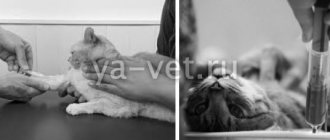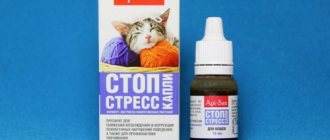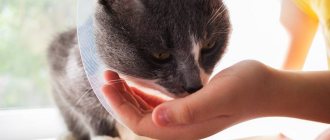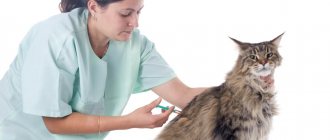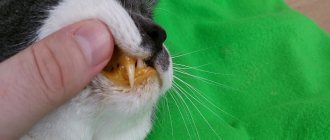Is the procedure dangerous?
We can absolutely answer: no! Donation is safe. Before the manipulation, the doctor calculates the required volume of blood, the taking of which will not affect the health of the donor.
In some animals, this procedure still has a small risk, since the collection requires the placement of an intravenous catheter and the administration of sedatives (the animal must lie still during the procedure). However, there is no need to worry - the drugs have a short-term effect, so the risk is minimal!
Cats of breeds at risk for diseases of the cardiovascular system should undergo an ultrasound examination of the heart (cardiological examination).
Possible consequences and precautions
You can reduce the risk of developing an allergy to foreign biomaterial in your pet with the help of appropriate medication.
An important factor is the compatibility of the recipient and his donor. The immunity of a cat with blood group B is incompatible with A, and vice versa. When inappropriate blood is administered, there is a danger to the life of a furry pet, so a test must first be done under the supervision of a veterinarian. Allergies may also occur. To avoid this, the cat is given an antihistamine before transfusion.
If the blood is stored incorrectly, or mistakes are made during transportation and defrosting, then it loses its quality and becomes the main cause of an acute reaction in the cat. If the rules of blood transfusion are not followed, the circulatory system is rebooted, so it is recommended to select only highly qualified specialists to carry out the procedure.
Requirements for a donor cat:
- age from 1 year to 7 years;
- weight from 3 kilograms;
- vaccination by age (annual, comprehensive);
- deworming and treatment against parasites (fleas and ticks);
- absence of episodes of viral diseases;
- good health throughout the year;
- absence of estrus, pregnancy, or nursing offspring at the time of the procedure.
Complications
Consequences during the implementation can arise at any time. They are divided into several categories: acute and delayed, immune and non-immune. Acute complications can occur due to thrombosis, enlargement of the heart, due to errors, etc.
Delayed complications occur as a result of transfusion of infected, overheated or hemolyzed (with destroyed red blood cells) blood cells. In these cases, infectious diseases begin to develop or anaphylactic, hemolytic shock occurs.
During transfusion, overload of the body is possible due to the speed of the manipulation. When too much volume enters the venous bed, the right side of the heart simply cannot cope with it. This situation leads to cardiac arrest and death of the recipient.
READ Apiary for beginners - building a hive from scratch
Requirements for a blood donor dog:
- age from 1 year to 7 years;
- weight from 25 kilograms (this is on average, it is better to check the weight with a doctor);
- vaccination by age (annual, comprehensive);
- deworming and treatment against parasites (fleas and ticks);
- absence of episodes of viral diseases;
- good health throughout the year;
- absence of estrus, pregnancy, or nursing offspring at the time of the procedure.
Possible consequences and precautions
After a blood transfusion, your furry pet does not need special grooming methods. For quick recovery after the procedure and good health of the pet, veterinarians recommend feeding the cat low-fat food and giving it the opportunity to rest. In the next 24 hours, it is better not to allow the cat to spend its free time too actively, and it is better to postpone outdoor games to the next day. Otherwise, care is no different from usual.
How the procedure works
A general blood test is taken from the donor. If the results are normal, a test is performed to determine the compatibility of the blood of the donor and recipient. If the blood is compatible, blood is taken from the donor for transfusion. The volume of blood taken from the donor is about 10% of the total volume of circulating blood.
Blood is taken from a vein on the thoracic, pelvic limb or from the jugular vein. The site for blood collection is specially prepared: the hair is shaved and the skin is treated with an antiseptic. Blood sampling occurs within 1-2 hours. The duration of the procedure depends on the calculated blood volume and the tolerance of the procedure by the donor. Blood is collected into a special container through an intravenous catheter.
If necessary, the animal is sedated (sedatives are administered).
Price
Prices for one appointment with a veterinarian-hematologist start from 700 rubles. The process of blood transfusion for a cat costs an average of 2500-3000 rubles. If necessary, a cross-test is prescribed, the price tag of which is about 500-600 rubles. Additional manipulations associated, for example, with plasma can cost 2500-3500 rubles. However, the price tag may vary, and only the administrator of a veterinary clinic will accurately answer the question of how much a specific procedure costs.
Blood transfusion is performed when the cat is in critical condition. Before the procedure begins, a number of studies are carried out to check the compatibility and health of the donor. Blood transfusions to cats are carried out under the strict supervision of specialists, because serious complications can arise at any time. An irresponsible approach to business leads to the fact that a sick pet will die or become infected with dangerous diseases.
Do pets have blood types?
Yes, dogs and cats have blood types. In cats they are called: A, B and AB. Blood type is determined by a test.
And in dogs, they mainly test for the presence or absence of an antigen, which is important for monitoring complications during blood transfusions.
In addition, a blood compatibility test is performed before the procedure. This is done in order to finally make sure that the pets’ blood is compatible with each other.
Compatibility
Cats have only 3 blood groups: A, B, AB. The first is the most common, B is a little less common. But the last - AB is the rarest and does not depend on the breed.
It is very important to establish in advance whether individuals are compatible. If you perform autotransfusion of different groups, then there is a high probability of rejection. It is characterized by an attack of the patient’s blood cells on foreign ones. Very often such situations are typical for B+A or B+AB. For this reason, only a compatible donor is needed.
There is another important factor. Mik erythrocyte antigen compatibility must be established before transfusion. It can be positive and negative. Accordingly, different categories cause a rejecting reaction in the recipient.
It is important! Unfortunately, there are no blood banks for pets, so owners are forced to look for a pet with a suitable blood type themselves.
What is needed to donate blood?
First of all, of course, desire and a healthy pet that meets the requirements for donors. You also need:
- Provide documents confirming the availability of annual vaccinations performed in a public or private clinic.
- Have a portion of food, water and a bowl with you.
- Take a leash, collar and muzzle (for dogs).
Symptoms of the disease
Leukemia always causes a sharp decrease in immunity in cats. An infected animal is susceptible to frequent illnesses that are severe and have complications that tend to recur.
The remaining symptoms are associated with secondary infection and depend on its type. The following violations are almost always observed:
- frequent rises in temperature;
- loss of interest in outdoor games;
- increased drowsiness;
- poor appetite and refusal to eat;
- frequent colds, gastrointestinal problems;
- very often drooling can be observed, since the virus localized in the salivary glands causes disruption of their functioning;
- swollen lymph nodes;
- pallor of the mucous membranes.
What can replace donated blood for animals?
Unfortunately, in modern veterinary medicine, unlike human medicine, synthetic blood substitutes have not yet been created. Most drugs for replenishing blood components are not suitable for animals due to their special specificity and can cause a severe allergic reaction in them. This is why it is so important for us that there are more and more blood donor animals. That's why your decision to participate in the donation program and save someone's life is so valuable.
Blood transfusion or blood transfusion is a type of infusion therapy during which either whole blood or its individual components (fractions) are transfused from the donor to the recipient.
For transfusion it is used:
- Whole blood with a preservative to prevent extravascular coagulation (most often sodium citrate, in a 4:1 ratio). Blood is taken from the donor into a sterile vessel, where it is mixed with citrate and additionally with isotonic sodium chloride solution. The use of any other solutions (glucose, Ringer, Ringer-Lock, etc.) is not allowed.
- Separate fractions of formed elements (platelet, erythrocyte mass, plasma). In this case, the desired fraction is separated using separation, mixed with an isotonic sodium chloride solution and introduced into the body.
Blood transfusion is crucial for any conditions associated with significant losses of blood or its individual elements: trauma, anemia of various origins (impaired kidney function, blood parasitic diseases, poisoning), autoimmune pathologies, insufficiency of coagulation factors, etc. To summarize , the indication for blood transfusion for animals is a hematocrit value below 10-15%.
On the left is the recipient's blood, on the right is the blood of the recipient and the donor. The difference in the number of formed elements is clearly visible.
Unfortunately, there is no alternative to human blood banks in veterinary medicine yet, so owners and veterinarians themselves are often forced to look for donors on their own. Not every animal is capable of becoming a donor.
Animals that meet the following conditions are allowed to donate:
- age 2-6 years;
- in cats, weight not less than 3 kg, in dogs - not less than 15 kg;
- availability of current vaccinations;
- absence of chronic diseases, carriage of viral and bacterial infections (confirmed by laboratory);
- satisfactory clinical condition;
- with a hematocrit of at least 40;
It is important to remember that the donor’s blood is a foreign biological material for the recipient, which is why it is necessary:
1. Prevent the occurrence of an allergic reaction and blood transfusion shock.
To do this, before the transfusion procedure, desensitizing therapy is carried out in the form of administering drugs that reduce the allergic response (calcium gluconate, dexamethasone) 10-15 minutes before the start of the procedure. It is worth noting that most often an immediate allergic reaction (urticaria, allergic swelling of the muzzle, neck, dewlap, sneezing and coughing with mucous discharge from the eyes) does not develop at all to the recipient’s blood, but to a preservative (the so-called citrate shock)
2. Prevent possible incompatibility between the blood of the donor and recipient
It is worth noting that in dogs, the percentage of incompatibility between the blood of the donor and the recipient during the first transfusion is extremely small due to the fact that specific antibodies have not yet formed in the bloodstream, which trigger the process of activating the immune response. But with repeated and subsequent transfusions in dogs, and with any blood transfusion in cats, it is necessary to conduct a so-called cross-test.
The essence of the test is as follows: the donor’s serum and the recipient’s formed elements are mixed in a separate small container, or vice versa. After this, everything is carefully mixed. After 5-7 minutes, the reaction is taken into account: if the formed elements are caught in a tight lump (hemagglutination), or, on the contrary, “melted” in the serum, turning it faintly red (hemolysis), the donor’s blood is considered unsuitable for the recipient due to incompatibility. In case of complete uniform mixing, the blood is considered compatible.
The required amount of blood for the recipient is calculated based on the indicators of a general blood test, namely, the hematocrit. It is generally accepted that to restore 1% hematocrit, the recipient needs to be transfused with 1-5 ml of whole blood X weight in kilograms.
Blood is collected from a donor, as a rule, immediately before transfusion to the recipient (an exception is plasma, which can be frozen for up to 15-20 days). The jugular vein is most often used to collect blood, and sometimes peripheral veins are used. If the procedure for collecting blood for a donor is unnecessarily traumatic, he is given sedation (most often for cats).
The transfusion procedure involves a long stay of the animal in a hospital setting, since the rate of blood transfusion is regulated in accordance with the patient’s condition and the duration of the procedure can reach 8-12 hours. In this case, the mixture for blood transfusion is periodically slightly warmed up to facilitate the absorption of the material, as well as to prevent temperature shock.
In the future, at least a week later, a maximum of a couple of weeks (7-21 days, depending on the massiveness of the blood transfusion and the initial severity of the condition), a control blood test is performed to determine the result.
Often, blood transfusion is a repeated procedure. On average, 3 to 5 transfusions are required to restore an animal after severe anemia. The frequency of blood transfusions and their volume are calculated individually in each individual case.
If the technique, blood transfusion rules, and precautions are followed, this is a relatively safe procedure, which has no analogues yet either in veterinary or humanitarian medicine.
Clinical case
Staffordshire Bull Terrier dog named Tofa at the age of 8 years.
She suffered from piroplasmosis, which caused renal failure and severe post-parasitic non-regenerative anemia, which was aggravated by weak production of erythropoietin by the kidneys.
Photo 1. The dog was so weak that he could not walk on his own, but after the transfusion he began to come to life. It is worth paying attention that for blood transfusion a special system is used with a filter in the chamber so that fine clots do not pass into the tube.
Photo 2. The patient behaved calmly during blood transfusion, the procedure was well tolerated, general symptoms were observed in the form of hyperthermia, slight shortness of breath, and redness of the mucous membranes. There were no symptoms of an allergic reaction, largely due to preliminary desensitizing therapy
Primary general blood test Tofa, changed indicators and norms:
RBC (erythrocytes) 1.39X10^12/L at a norm of 5.50-8.50
HCT (hematocrit) 9.6% with a norm of 37-55
HGB (hemoglobin) is not detected
WBC (leukocytes) 0.24X10^12/L at a norm of 5.5-16.9
PLT (platelets) 150 k/µL at normal 170-500
Primary biochemical blood test of Tofa, changed indicators and norms:
UREA (urea) 16.8 mmol/L at a rate of 2.5-9.6
CREA (creatinine) 335 µmol/L at a norm of 44-159
Due to the small number of red blood cells, active detoxification therapy could not be carried out in order to avoid an increase in hypoxic syndrome. It was decided to conduct a trial blood transfusion in 2 stages: on the day of blood sampling and a couple of days later. The large volume of blood, divided into two, was intended to reduce the load on all body systems, especially the urinary system.
The dog's first transfusion contained approximately 150 ml of whole blood, corresponding to a recovery of approximately 7 units. hematocrit. During the second main transfusion, the patient was given a total of about 400 ml of whole blood.
In the intervals between blood transfusions, the dog was administered solutions subcutaneously and intravenously, symptomatic therapy was carried out, and a diet was prescribed. Interim monitoring of the treatment was carried out based on biochemical parameters, as well as based on the animal’s well-being, which improved significantly a week after the second blood transfusion.
Control blood tests were done only after a couple of months:
Control general blood test Tofa, changed indicators and norms:
RBC (erythrocytes) 7.66X10^12/L at a norm of 5.50-8.50
HCT (hematocrit) 55% when the norm is 37-55
HGB (hemoglobin) 17.6
WBC (leukocytes) 6.0X10^12/L with normal 5.5-16.9
PLT (platelets) 313 k/µL at normal 170-500
Control biochemical blood test of Tofa, changed indicators and norms:
UREA (urea) 7.2mmol/L at a rate of 2.5-9.6
CREA (creatinine) 220 µmol/L at a norm of 44-159
Subsequently, Tofa pleased us with a long-term remission and, despite the fact that renal failure is a disease that cannot be completely cured, the dog received a favorable prognosis.
Precautions for blood transfusions in cats.
Although transfusion can save a cat's life in many cases, due to the potential for serious complications, care must be taken to ensure that the transfusion does not endanger the health of both cats.
- It is necessary to ensure that the donor and recipient have compatible blood types. At a minimum, it is necessary to check what blood type is A, B or AB in cats, and ideally, a comparative analysis is carried out to identify the Mik antigen and other incompatibilities;
- The donor cat should be tested for blood-borne infections, including feline leukemia virus (FeLV), feline immunodeficiency virus (FIV), and mycoplasma (which causes infectious anemia);
- Great care must be taken to avoid overloading the recipient cat's circulatory system during transfusion, as this can lead to heart failure. As a rule, because of this, blood transfusions must be given quite slowly;
The condition of the recipient cat must be carefully monitored, especially at the beginning of the transfusion procedure, in order to notice an undesirable reaction in time. The first five milliliters of blood should be transfused very slowly (approximately 1 ml/kg/h over half an hour) to be able to immediately react to possible problems.
To ensure the safety of the donor cat, donated blood must be collected in such a way as to minimize the risk to its health. Basic requirements for a cat to become a donor include:
- The cat must be healthy, fully vaccinated and preferably never left home;
- Be under the age of eight years;
- Have a weight of at least 4.5 kg;
- The hematocrit value should be at least 30%, ideally from 35%;
- Do not suffer from infectious diseases (such as feline immunodeficiency virus, feline leukemia and hemoplasmosis) Do not experience the stress of visiting a veterinary clinic;
Even if all of the above conditions are met, donating blood is associated with a certain risk - when blood pressure drops due to fluid loss, previously undetected heart disease can sometimes manifest itself; an altered blood volume can cause heart failure and even the death of the donor cat. To exclude such cases, ultrasound and heart scans are sometimes performed before donating blood to detect hidden diseases.
When does a cat need a blood transfusion?
A blood transfusion can immediately raise the level of red blood cells, which carry oxygen throughout the cat's body. This is why a blood transfusion can save the life of an anemic cat. Blood contains many important elements, the main ones of which are the following:
Red blood cells (erythrocytes).
These cells carry oxygen to all organs of the body. To estimate the total volume of red blood cells, a simple blood test for hematocrit (Ht - Hematokrit, PCV - Packed Cell Volume) is used. Normally, a cat's hematocrit should be between 25 and 45%. Although individual rates vary for each cat, blood transfusions are required at 10-15%.
Plasma.
The liquid component of blood (in which red blood cells “float”). Plasma contains proteins with a certain functionality, the main of which can be considered albumin, which helps maintain the required level of fluid in the circulating blood. Many chemicals and hormones are carried throughout the body by binding to albumin. Proteins responsible for blood clotting are also critical, as they are responsible for reducing blood loss when blood vessels are damaged. Plasma also contains a group of proteins (anti-inflammatory mediators) that help the cat’s body cope with infection and fight inflammation.
Platelets.
Very small blood cells that work in conjunction with clotting factors to help stop bleeding after fractures and other injuries.
It is potentially possible to separate blood into these components (red blood cells, platelets and plasma), as is done in human medicine, to use them separately when appropriate. However, while this approach is sometimes used for blood transfusions in dogs, it is much less common in cats, in part because cat blood (specifically red blood cells) cannot be stored for long. Therefore, fresh blood is usually used for blood transfusions in cats.

